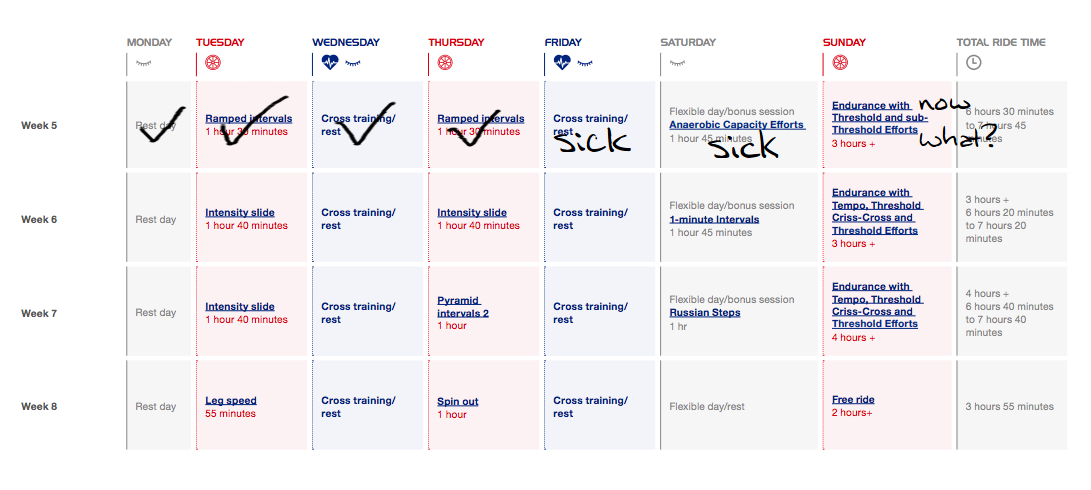The Challenges with Training Plans
Traditional training methods are primarily focused on the training plan. A training plan is normally a pre-defined series of workouts, almost always structured workouts, that are scheduled on your calendar that you follow, day-to-day, week-to-week. The most effective training plans are designed professionally by an experienced coach, tuned for each individual, preparing them for one or more events. But often times they are just a pre-defined series of workouts that you simply perform in order to gain some structure to your training.
There are several limitations with the many training plans you often see:
- They don’t have an awareness of the initial training status of the athlete. Athletes start their training towards a particular goal with a varying amount of established training already there. Some athletes are untrained making it difficult for them to do more aggressive training plans. Others have a lot of training already “in their legs” when they start training. Having them both do the same training plan would be a mistake.
- Many that are based on power, use %FTP to assign workout interval targets. The dependency on having a well-established FTP is one issue but the more important issue is that as intervals increase in intensity, the individual differences between athletes with the same FTP can be significant. We elaborated on this problem in our blog: Paradigm Shift in Training.
- Athletes are not always able to complete workouts. Athletes lead busy lives balancing work, home life and their training. They get sick. They are away on business. Following a rigid, inflexible plan weakens the periodization that the entire plan is designed to do. For example, following a pre-defined plan, after missing a week due to work travel, would be a big mistake.
- Athletes don’t always have the same amount of available time throughout the plan. Some weeks you may have 14 hours available, some weeks only 5 hours. Schedules change and life brings different demands on you. An inflexible training plan will increasingly prescribe workouts that may not be the ideal ones that you should be performing on a given date.
- Rigid plans don’t allow for ad-hoc group rides or fun rides. Some plans are so rigid, that athletes are left training alone, day-in and day-out in order to “stay on plan”.
Addressing Training Plan Limitations
The new Xert Adaptive Training Advisor (XATA), offers athletes a way to address these limitations. XATA has been designed to do the following:
-
- It considers your recent history to measure how much training you’ve been doing and to then determine how much you should be doing.
- It allows you to choose how much improvement you are seeking to achieve.
- It helps you assess whether you have the freshness to do a high-intensity workout or whether that should wait.
- Training more allows you to accelerate your gains.
- Based on your program type and target event date, the focus of your training is periodized, week-to-week, day-to-day, to prepare you for your event.
- Using all the information gathered about you and your goals, XATA ranks every workout – as well as your recent unstructured outdoor & virtual rides – according to what will be best for you.
- Any workout you choose or that gets recommended will have interval targets that exactly match your abilities at that given moment.
- Recommended workouts have a difficulty that is matched to your current training load. The more training you do, the harder the recommended workouts.
- Everything you do is accounted for and is used to make adjustments to your workouts, all the time.
XATA’s training recommendations are:
- Progressive – Training load increases week-to-week, based on where you are at every moment.
- Periodized – Workouts are adjusted from Base (Endurance) to Peak (desired Focus) as your target event date approaches.
- Adaptive – Recommendations change as you execute the plan. Miss a workout or do something different, XATA adjusts automatically.
- Personalized – Workouts are highly personalized to you, your specific fitness level and your ability to handle more difficult workouts.
XATA Fundamentals: Improvement Rate
The key driver behind the XATA assessments and recommendations is your chosen Improvement Rate. Your improvement rate is used to establish the volume of training you will need to perform on a week-to-week basis in order to maintain fitness progression. Setting it too low, you may not reach the levels you would like to reach. Setting it too high, you may not have the available time or the ability to withstand the demands of the training.
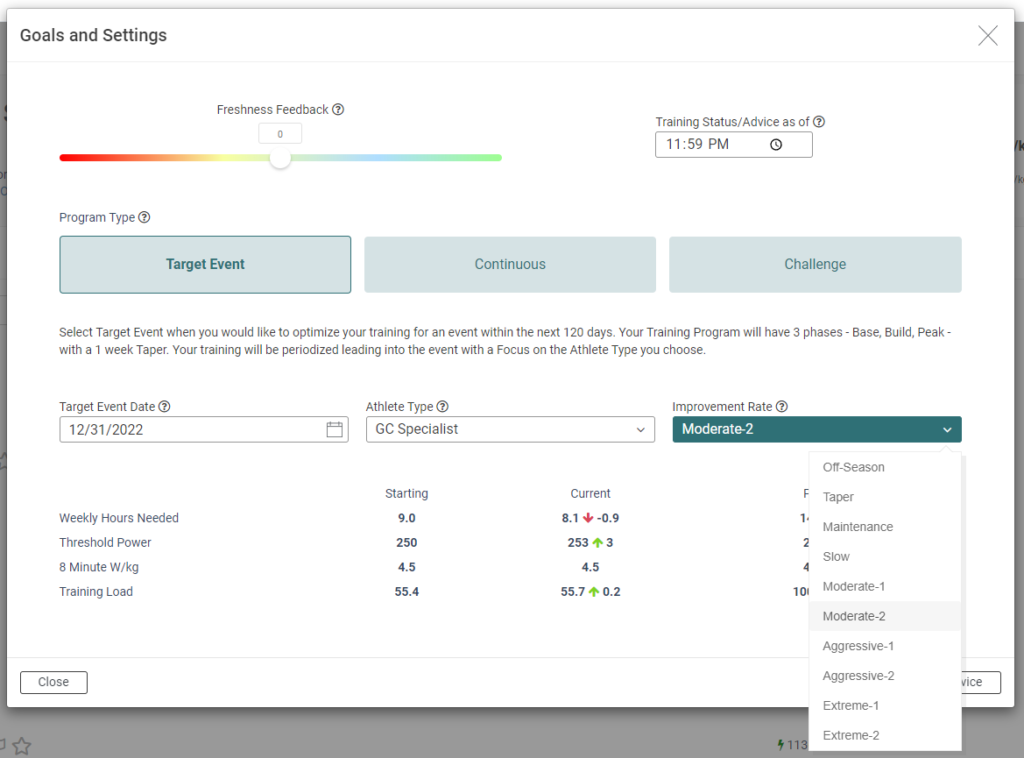
You should choose the improvement rate based on your available time to train. XATA calculates how much time you will need on a weekly basis to sustain the improvement rate you have chosen. This is in many ways the inverse to how traditional training plans are chosen .. but traditional training plans don’t have the benefit of seeing exactly where you are today in your development and progression. XATA establishes, based on where you are today and from your rate of improvement you desire, the amount of time you will need to invest to obtain those gains. It also, then uses your historical relationship between each individual system – low, high, peak – training loads with your fitness signature parameters to forecast their future values, both out 6-weeks as well as to your Target Event Date, should you sustain the improvement rate the entire time.
XATA Fundamentals: Xert Training Pacer
To simplify training with XATA and to address the need for training flexibility, we’ve introduced an entirely new concept called the Xert Training Pacer:
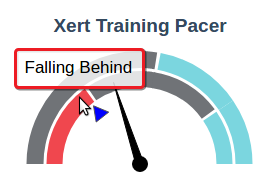
This gauge provides a simply visual cue as to whether your training is on-target (inner grey), is ahead of plan (inner blue) or if you are falling behind (inner red). It also indicates if you need to train (outer grey) or if training is optional (outer blue). Using your mouse cursor, you can mouse-over the sections to see which sections are being referenced. So if the main needle points to the TRAIN section, you should consider planning a training session soon. If it points to TRAINING OPTIONAL, you could train if you wish to. If you’re BEHIND SCHEDULE it means you are falling behind on your weekly improvement rate goal and you should increase the volume of your next few workouts to get back on track. (N.B. Don’t feel that you need to close the deficit gap all at once. The advice and recommendations offered will help you close the gap over time.) But if you’re falling further and further behind, it may mean that you’ve chosen an Improvement Rate that requires a weekly commitment that is beyond what you have available. On the opposite end, if you’re AHEAD OF PLAN, you’re improving at a rate that’s higher than what you have set. Often this corresponds with a Training Status of Very tired, which means you need to rest and recover before you can train again. XATA tracks both for you.
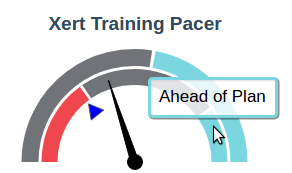
The pacer on your My Fitness home page also shows you what your Training Status will be tomorrow (i.e. in 24 hours), based on any planned activities. This is the coloured triangle on the gauge. Blue arrow is depicted here:
If you are consistently AHEAD OF PLAN and your Training Status is Fresh or Very fresh, you may consider increasing your Improvement Rate as you have more time available to obtain greater gains in fitness and have a greater capacity to train.
Choosing and Performing Workouts
XATA has a feature that will automatically select a workout for you from the library of workouts you have available (i.e. Standard, Coach and Personal workouts). It will rank them and present the top options for you. Use the ‘duration’ filter to quickly select how much time you have to train – you should always use this if you have more (or less) time to train – Xert will still present the top workouts for you based on your available time. You can also use the ‘Filter‘ button to more detailed workout filtering. Clicking the ‘Suggest’ button will randomly select one of the top training recommendations for you:
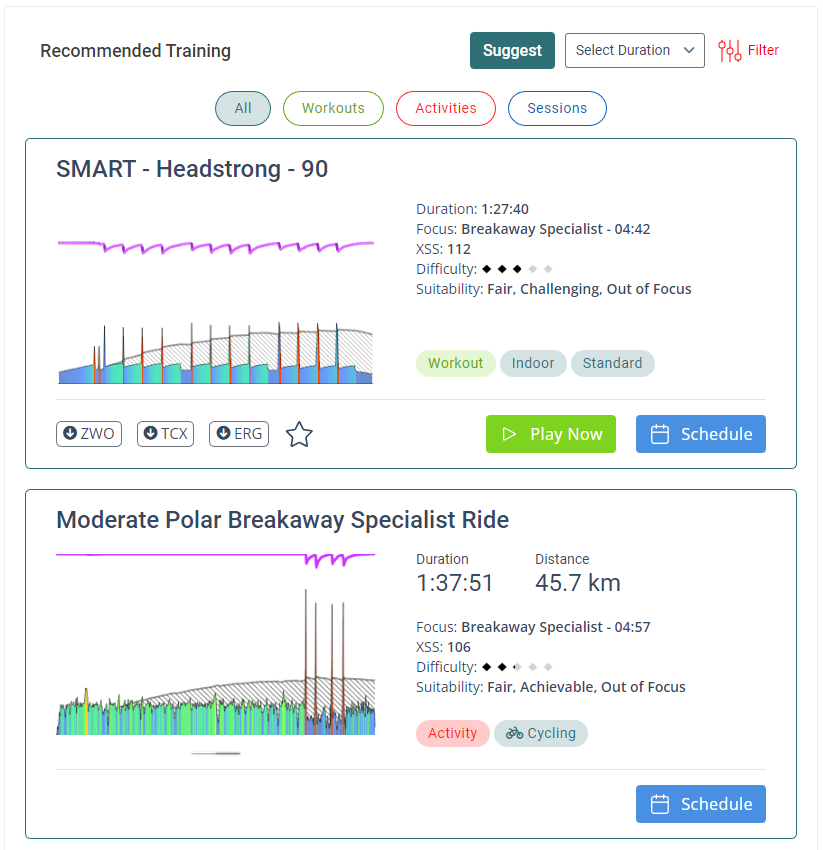
XATA allows you to incorporate group rides or unstructured workouts easily into your schedule. If you decide to go out with some riding partners one day, the amount of XSS you accumulated will be accounted for moving forward. XATA may suggest an Endurance workout if your status is Tired or suggest that your next workout is optional, for example. (Had you had a hard, high-intensity workout scheduled in a traditional training plan you may end up with a failed workout.) XATA adapts to what you do.
You can also have an awareness of the goals you need to be acheiving during your next activity if you plan on just riding, either outdoors without any definite structure or perhaps riding in an environment like Zwift. Having an awareness of your XSS Deficit and Focus goals of the workout, you can ride and keep an eye on your total XSS and Focus and look to get things back on-track. Having things on-track, you know you are improving at the rate your have set as your goal.
Overloading
Some athletes looking to sustain Aggressive or Extreme improvement rates can consider higher volume/intensity despite having a status of Tired or Very tired. This can be done temporarily as part of an overloading period to generate more Training Load before a recovery period. XATA will not recommend this but athletes are free to choose non-Recovery / non-Endurance workouts manually. However, be cognizant of possible over-training.
Recovery Weeks
Training improves your fitness and thus increases your fitness signature parameters. This is one of the main goals of training. But, as many know, training also makes you tired and recovering from training is important. Trouble is, recovering also gets in the way of more training and so many athletes forego the recovery and simply continue to train without it. This methodology isn’t sustainable. Eventually you’ll be too tired to train with appropriate intensity or worse, you may fall into the over-training trap.

XATA helps you identify if you should consider slowing things down in order to allow your body to recover. When XATA detects that your Training Status is Very tired but you are starting to fall behind in your training, this is a tell-tale sign that your Improvement Rate may be too much for you at that moment. When this occurs, the training advice displayed will provide a warning that you should consider reducing your Improvement Rate temporarily to allow your body to recover from the tiredness you may have. In traditional training plans, this is often called a “Recovery Week”. XATA will similarly look at your data and recommend a recovery week when it’s time. If XATA indicates that you are falling behind but your status is Very tired, use the Training Advice button to see if additional recovery is recommended.
Once you lower your Improvement Rate to Maintenance, XATA will recommend more optional training and reduced XSS targets for your goals, allowing your more time in-between workouts and less strenous workouts too. Once you recover freshness status, increase your improvement rate back to where you prefer and continue your training with higher XSS targets and goals.
Tapering
Similar to recovery weeks, tapering involves reducing the volume of your training in order to allow the body to recover in preparation for an event. During the 1 to 2 weeks leading into your event, particularly if you’re coming off of a block of very high Improvement Rate (Aggressive or Extreme, for example), you can reduce your Improvement Rate to Taper which will reduce deficits / increase surpluses and start to scale down your training volume, allow your body to recover and be ready for the event.
How XATA Works
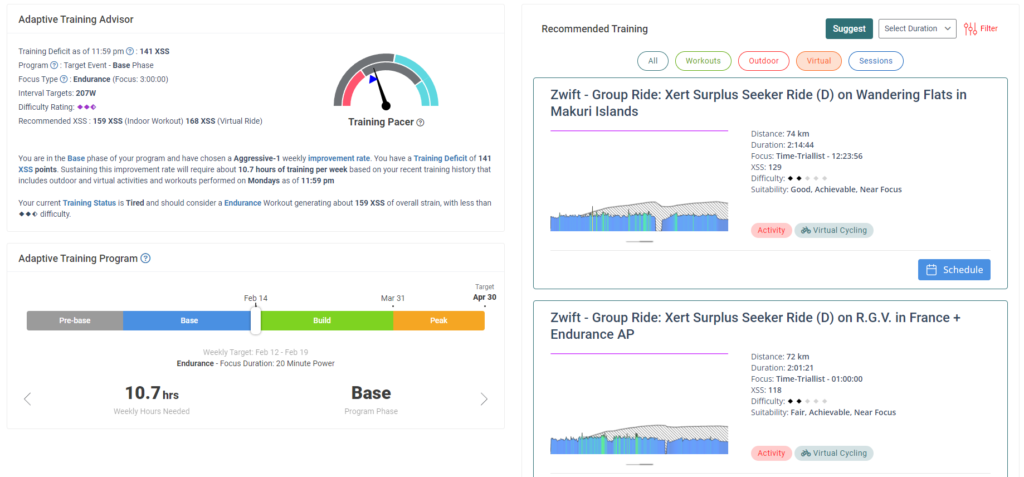
Under the covers, XATA combines a lot of what Xert is measuring and tracking for you and sums it all up for you in a way that makes it actionable at every given moment. Rather than base your training prescription on something that was established at the beginning of a training plan, XATA looks at the previous week and your accumulated training load to determine what your Training Deficit/Surplus will be at any given time. On your My Fitness home page, XATA establishes your deficit or surplus as of right now. Knowing this and how many workouts you’ve done and how much XSS you typically accumulate, XATA thens calculates how much strain you should aim for. XATA also looks at your Target Event Date to determine which phase your training program is in and determines what the Focus should be for your training. XATA will increasingly move your training towards your Target Athlete Type as your Target Event Date nears. Notably though, if your Training Status is red (Very tired), XATA will recommend a recovery ride independent of your deficit or surplus. If your Training Status is yellow (Tired), XATA will recommend an Endurance workout. If your status is Fresh or Very Fresh, you’ll have free reign to do a high-intensity workout if you’re in the Build or Peak phase of your program. (When you’re in the Base phase or if your Target Athlete Type is Triathlete, Century Rider or Time-Triallist, your workouts will always be Endurance workouts, only the Difficulty Rating and amount of XSS will vary as your Training Load increases.)
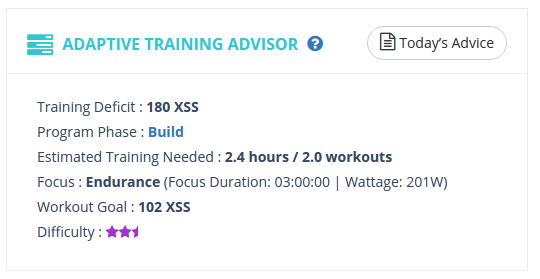
XATA uses your Training Status information as part of the workout scoring process. When your Training Status is Fresh or Very Fresh, XATA will recommend workouts according to your current Target Focus, as determined by the training program. Below is an example training program for a Puncheur. In the base phase, training is focused on Endurance. In the peak phase, it is focused on Puncheur. In between, the change is periodized. Note that XATA will not exclusively recommend workouts in the specific focus. The ranking algorithm simply scores them higher.
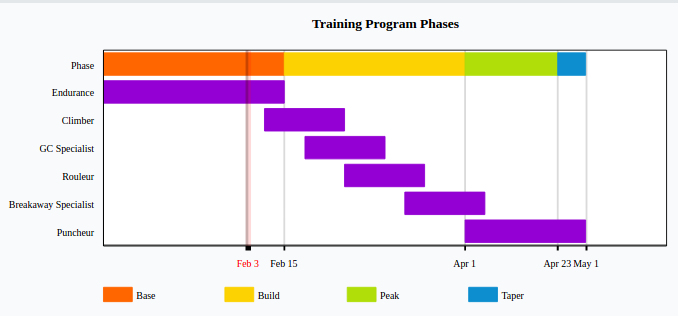
Program Periodization for Puncheur-Focused Athlete
